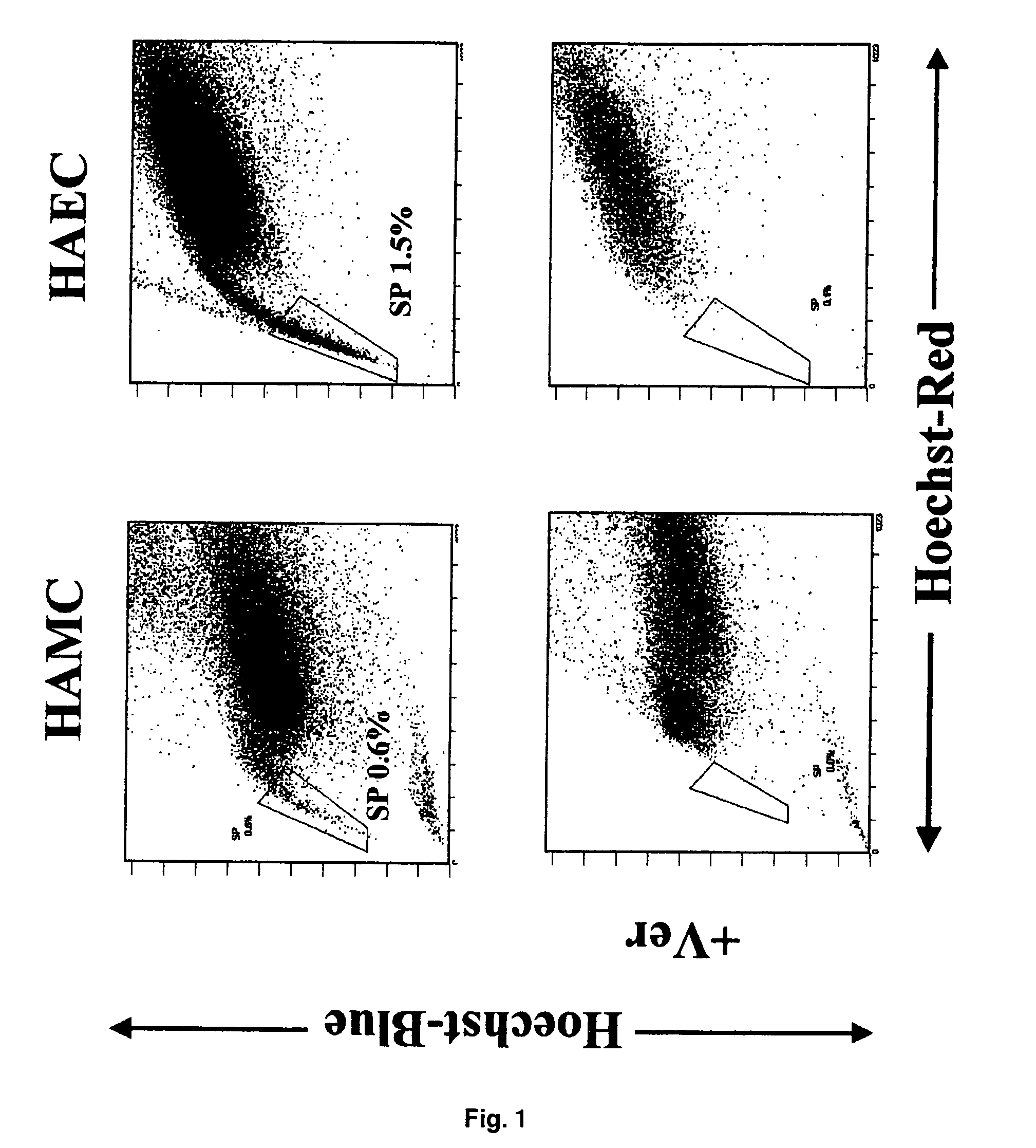Side population cells originated from human amnion and their uses
a technology of amnion and side population, applied in the field of amnion separated cells, can solve the problems of inability to transplant cells, no radical therapeutic method for lysosomal disease, and inability to supply stably
- Summary
- Abstract
- Description
- Claims
- Application Information
AI Technical Summary
Benefits of technology
Problems solved by technology
Method used
Image
Examples
example 1
Separation of SP Cells
1. Separation of Amniotic Cells and Primary Culture Thereof
[0023] (1) After informed consent, HAMC layer and HAEC layer were separated by being peeled off from the chorionic membrane layer in a placenta after scheduled Caesarean operation.
[0024] (2) The layers were treated with 0.25% trypsin solution / 10.3 mM EDTA at 37° C. for 15 minutes. This operation was repeated 4 times. The trypsin solution fraction was centrifuged to collect the cells, and the cells were washed three times with phosphate buffer (PBS) to obtain HAEC.
[0025] (3) After washing the non-digested fraction with PBS, the cells were treated with a mixed enzyme (0.01% papain, 1 mg / ml of collagenase, 0.01% DNase and 0.1% neutral protease) at 37° C. for 1 hour under shaking.
[0026] (4) The resultant was centrifuged at 2000 rpm for 10 minutes, and the obtained precipitate was washed three times with PBS, followed by filtering the cells through a filter with an average pore size of 40 μm to obtain ...
example 2
Analysis of Expressions of Genes by RT-PCR
[0041] (1) Total RNAs were extracted from cultured cells after 10 passages using High Pure RNA Isolation Kit (Roche).
[0042] (2) Using M-MuLV Reverse Transcriptase (Roche), cDNAs were synthesized from the obtained total RNAs. The conditions for the synthesis of cDNAs were as follows: [0043] 5×Incubation buffer 4 μl [0044] 10 mM dNTP mix. 2 μl [0045] 0.1 M DTT 2 μl [0046] Random primer 1 μl [0047] (or Oligo dT(18) primer) 1 μl [0048] RNase inhibitor 0.5 μl [0049] DEPC treated water 5 μl [0050] Reverse Transcriptase 0.5 μl [0051] RNA 5 μl [0052] Total 20 μl
[0053] PCR was carried out under the following conditions: [0054] 10×reaction buffer 5 μl [0055] 2.5 mM dNTP mix. 5 μl [0056] 50 μM forward primer 1 μl [0057] 50 μM reverse primer 1 μl [0058] Distilled water 32.5 μl [0059] Taq DNA polymerase 0.5 μl [0060] cDNA 5 μl [0061] Total 50 μl
[0062] The primers used for the PCR for amplification of the respective genes had the following nucleotide ...
example 3
[0064] (1) Cultured cells were fixed with 4% paraformaldehyde for 1 minute and the fixed cells were incubated with a primary antibody at room temperature for 2 hours.
[0065] (2) The resultant was then incubated with a secondary antibody diluted with 0.3% Triton X100 (trademark) for 2 hours.
[0066] (3) The immunoblotted cells were observed with a fluorescence microscope and confocal image observed with a confocal laser scanning microscope was analyzed.
[0067] (4) The primary antibodies used were anti-human nestin polyclonal antibody, anti-human musashi-1 monoclonal antibody, monoclonal antibodies to CK19 (Santa Cruz), vimentin (PROGEN), CD4 (IMMUNOTECH), CD8 (IMMUNOTECH), CD13 (IMMUNOTECH), CD15 (IMMUNOTECH), CD29(IMMUNOTECH), CD34(IMMUNOTECH), CD38 (IMMUNOTECH), CD43 (IMMUNOTECH), CD44 (IMMUNOTECH), CD45 (IMMUNOTECH), CD49b (IMMUNOTECH), CD50 (IMMUNOTECH), CD56 (IMMUNOTECH), Thy-1 (IMMUNOTECH), CD106 (IMMUNOTECH), c-kit (IMMUNOTECH), HLA-DR (Ancell), HLA ClassI, Flt-1...
PUM
| Property | Measurement | Unit |
|---|---|---|
| wavelengths | aaaaa | aaaaa |
| wavelengths | aaaaa | aaaaa |
| pore size | aaaaa | aaaaa |
Abstract
Description
Claims
Application Information
 Login to View More
Login to View More - R&D
- Intellectual Property
- Life Sciences
- Materials
- Tech Scout
- Unparalleled Data Quality
- Higher Quality Content
- 60% Fewer Hallucinations
Browse by: Latest US Patents, China's latest patents, Technical Efficacy Thesaurus, Application Domain, Technology Topic, Popular Technical Reports.
© 2025 PatSnap. All rights reserved.Legal|Privacy policy|Modern Slavery Act Transparency Statement|Sitemap|About US| Contact US: help@patsnap.com

